Michael Topham takes a closer look at Canon's latest double-digit DSLR - the EOS 80D
Canon EOS 80D review: First Look
Canon EOS 80D review: Hands-on First Look
At a glance:
- 24.2-million-pixel APS-C sensor
- DIGIC 6 image processor
- EF/EF-S lens mount
- ISO 100-16,000 (extendable to ISO 25,600)
- 7fps continuous shooting
- 3.5mm headphone input
- £999.99 (body only)
Having recently refreshed its EOS for professionals line-up with the release of the new EOS 1DX Mark II, Canon has returned its focus to the EOS for enthusiasts range by announcing the EOS 80D. Arriving two and a half years after the EOS 70D, the EOS 80D is the latest release in a flurry of new announcements ahead of the forthcoming CP+ Camera and Photo Imaging expo in Japan. It looks set to be an attractive offering for aspiring photographers as well as those looking to progress through the EOS line-up from an entry-level triple-digit EOS DSLR to a more advanced double-digit model.

Features
The notable change in the Canon EOS 80D is its sensor – instead of adopting the 20.2-million-pixel CMOS sensor from the EOS 70D, it employs a new 24.2-million pixel CMOS sensor. This pairs up with Canon’s DIGIC 6 image processor to provide an ISO range of 100-16,000 (expandable to ISO 25,600). Continuing where the EOS 70D left off, the EOS 80D is the second double-digit EOS model to benefit from Dual Pixel CMOS AF technology. Each microlens covers two photodiodes that can be read independently, and by measuring the difference in light that reaches each of the two diodes, the EOS 80D can perform on-sensor phase detection focusing when using live view and shooting HD video. To enhance operation in this department Canon has introduced options to refine the AF speed and AF tracking sensitivity, giving users extra control over the responsiveness of autofocus in Live View for the very first time.
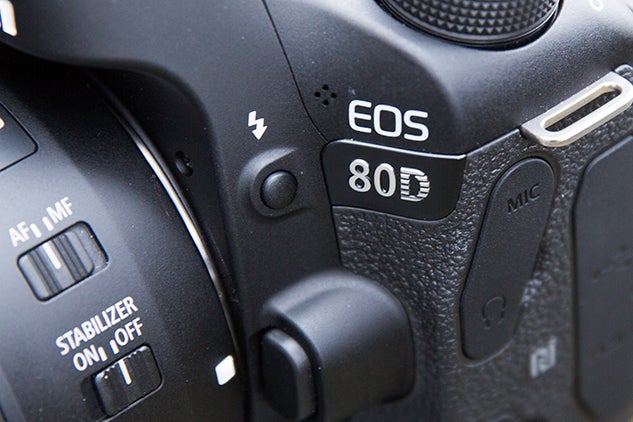
The improvements to autofocus don’t end here. The EOS 80D features 80D features an AF system with 45 all cross-type points that’s not too dissimilar to the system found in the Canon EOS-1D Mark IV. Out of the 45 AF points on offer, 27 are f/8 compatible, with the centre point being sensitive down to f/2.8. The working range of the autofocus system (-3EV-18EV) is broad so we can expect a responsive AF performance in low light.
Moving onto metering, this is left in the capable hands of Canon’s 7,560-pixel RGB+IR metering sensor and to counteract the rapid on/off pulsing of certain artificial lights the EOS 80D employs Canon’s Flicker Detection technology that made its debut in the EOS 7D Mark II. Despite benefiting from Canon’s newer DIGIC 6 image processor, the EOS 80D continues to shoot a continuous burst at 7fps like the EOS 70D. If you’d like to shoot discreetly it’s possible to shoot at up to 3fps in the camera’s silent shooting mode and there’s the option of shooting at up to 5fps in Live View.
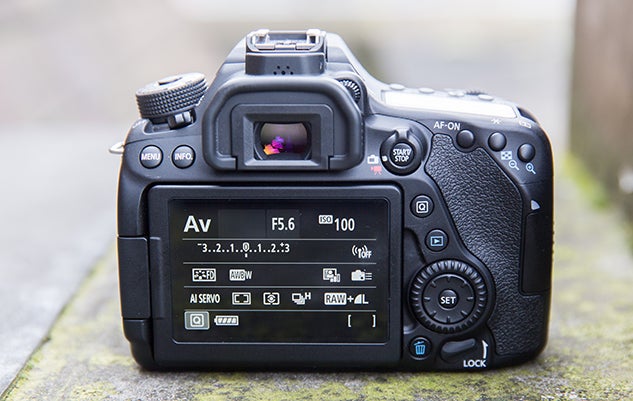
The key benefit of the new processor is reflected in the EOS 80D’s buffer depth. It can record 110 JPEGs or 25 raw files at up to 7fps, which is a step up from the EOS 70D that could manage 65 JPEGs and 16 raw files. Like the EOS 70D, the viewfinder displays a camera level indicator to avoid skewed horizons and rather than producing 98% coverage, it now displays 100% of the frame with 0.95x magnification. Below the viewfinder little has changed. The EOS 80D borrows the 3in, 1,040k-dot resolution touch-sensitive display from the EOS 70D and it’s hinged at the side, allowing it to be pulled out, tilted and swivelled to suit a broad range of shooting angles.
Videographers have the ability to shoot Full HD (1920×1080) movies at up to 60p for a maximum duration of 29 minutes 59 seconds. Other frame rates (50, 25 and 24fps) are available and users of the EOS 70D who criticised the lack of a headphone socket to monitor audio levels will be glad to know the EOS 80D features both headphone and microphone inputs at the side of the body for full audio control.
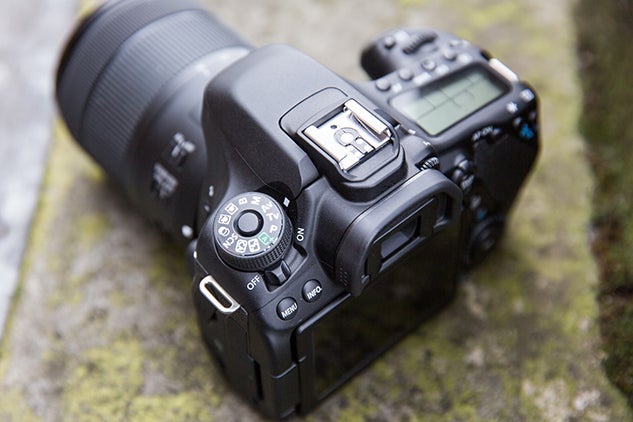
As we’ve seen on most Canon DSLRs of late, Wi-fi and NFC connectivity are both built in, offering photographers the freedom to control the camera remotely from a smartphone or tablet that’s running Canon’s Camera Connect app. Elsewhere, a new fine detail effect has been added to the picture styles, it accepts the same LP-E6N battery as the 70D and it’s 25g lighter than its predecessor.
Build & Handling
You’ll notice little has changed in terms of the appearance of the EOS 80D, which is testament to the excellent design of Canon’s double-digit series. From the front it’s near identical to the EOS 70D, with the larger pentaprism and in-built microphone holes above the model number being the only visual differences. At the back of the camera it’s much the same story, but those with an eye for detail will notice an enlarged thumb grip, which contributes to a slightly better purchase in your right hand.
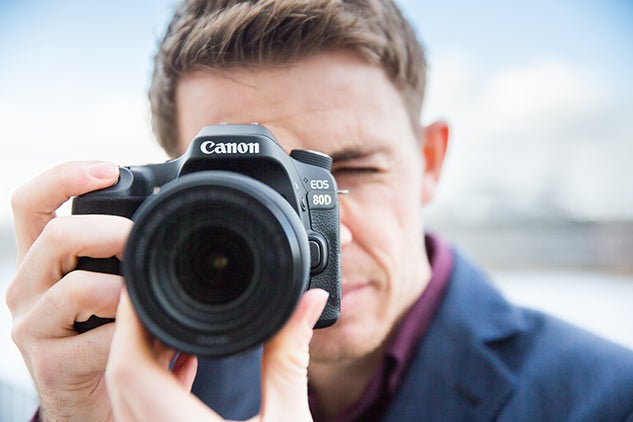
Playback and quick menu buttons are now circular unlike before and it inherits the superb AF area selection button that featured on the 70D, which in conjunction with the intelligent viewfinder, allows you to quickly toggle through AF area modes without the need to lower the camera from your eye.
Again like the 70D, the body is constructed from aluminium and polycarbonate resin with glass and conductive fibre, and feels well built, albeit not to the same weather-resistant standard as the EOS 7D Mark II. At the side the new headphone port is located below the microphone port and a quick glance above the on/off switch reveals you can now take control of creative filters and access a second custom setting (C2) direct from the mode dial.
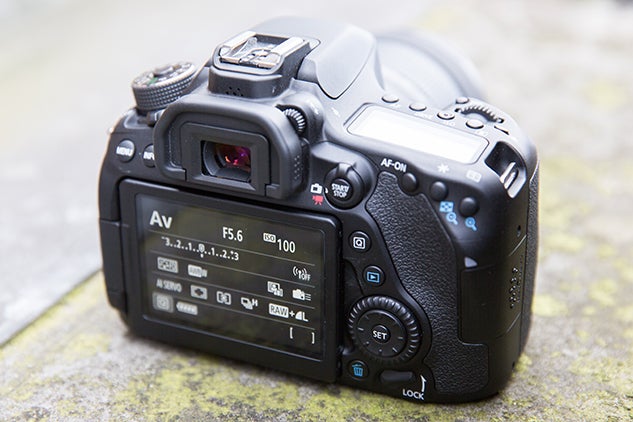
The EOS 80D will be available to buy body-only for £999 and is expected to be available in May.
Canon EF-S 18-135mm f/3.5-5.6 IS USM
At the same time as announcing the EOS 80D, Canon has revealed its first lens to feature all-new Nano USM focus technology. The EF-S 18-135mm f/3.5-5.6 IS USM is different from lenses we’ve seen before in the way it merges the best of Canon’s Ultrasonic motor technology (USM) and Stepping Motor lens technology (STM) to create the best blend of smooth, quiet autofocus for movie recording and blistering speed for stills. Like the Canon EF-S 18-135mm 3/3.5-5.6 IS STM lens, this new EF-S 18-135mm f/3.5-5.6 IS USM features an optical construction of 16 elements in 12 groups with 7 aperture blades.

As well as being able to use it like you would a conventional lens, the EF-S 18-135mm f/3.5-5.6 IS USM supports the attachment of an optional Power Zoom Adapter PZ-E1 (£120), a device that brings multiple advantages to zoom operation when shooting movies. This compact and lightweight accessory attaches to the underside of the lens and provides fingertip power zoom control for ultra-smooth zooming at fast or slow speeds via its mechanical-drive and electronic contacts.
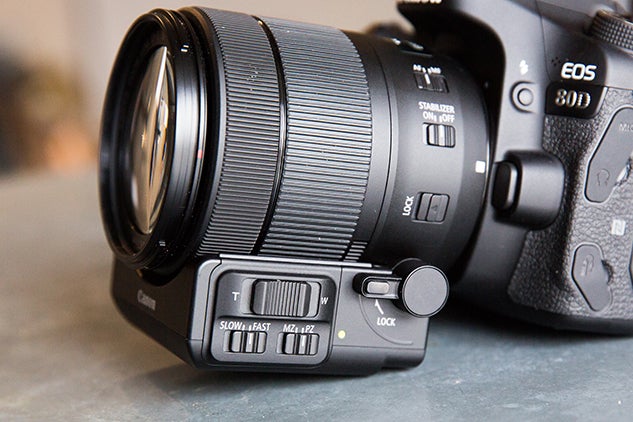
The Power Zoom Adapter PZ-E1 is powered by 4xAAA batteries and supports zoom operation via Wi-fi from a mobile device running Canon’s Camera Connect app. During our time with the EOS 80D we had an opportunity to get hands on with the new EF-S 18-135mm f/3.5-5.6 IS USM lens. Though Canon has admitted there are no plans to sell this new lens with the camera as part of a kit, the pair feel nicely balanced and compliment each other well.

Attaching the Power Zoom Adapter PZ-E1 requires you to upturn the lens and align two catches with two grooves positioned either side of the electronic contacts. To secure it and lock it in position, the lock lever has to be rotated by 90 degrees clockwise. Once the Power Zoom Adapter is attached it’s instantly ready to use. In Power Zoom (PZ) slow zoom mode the lens does exactly what you’d expect – it zooms incredibly smoothly very, very slowly. Flick the speed switch back towards you and the lens zooms across its range just as smoothly, albeit slightly faster. These ultra smooth zoom transitions will benefit videographers and bloggers who’d like to apply professional-looking zoom effects to their movie footage easily with minimal fuss and minimum expense.
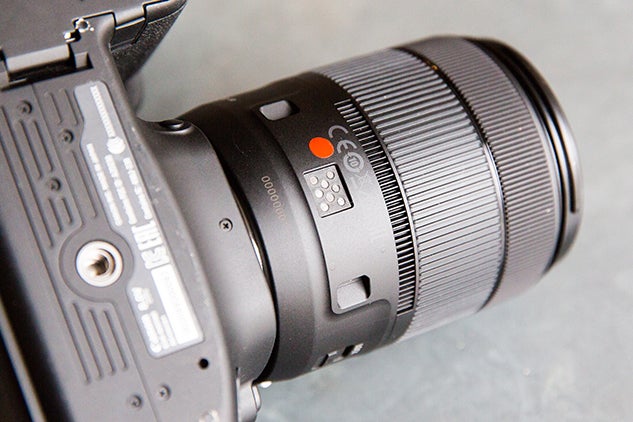 The EF-S 18-135mm f/3.5-5.6 IS USM is expected to be available in May and will cost £439. The Power Zoom Adapter PZ-E1 is expected to be available around the same time and will cost £129.
The EF-S 18-135mm f/3.5-5.6 IS USM is expected to be available in May and will cost £439. The Power Zoom Adapter PZ-E1 is expected to be available around the same time and will cost £129.




